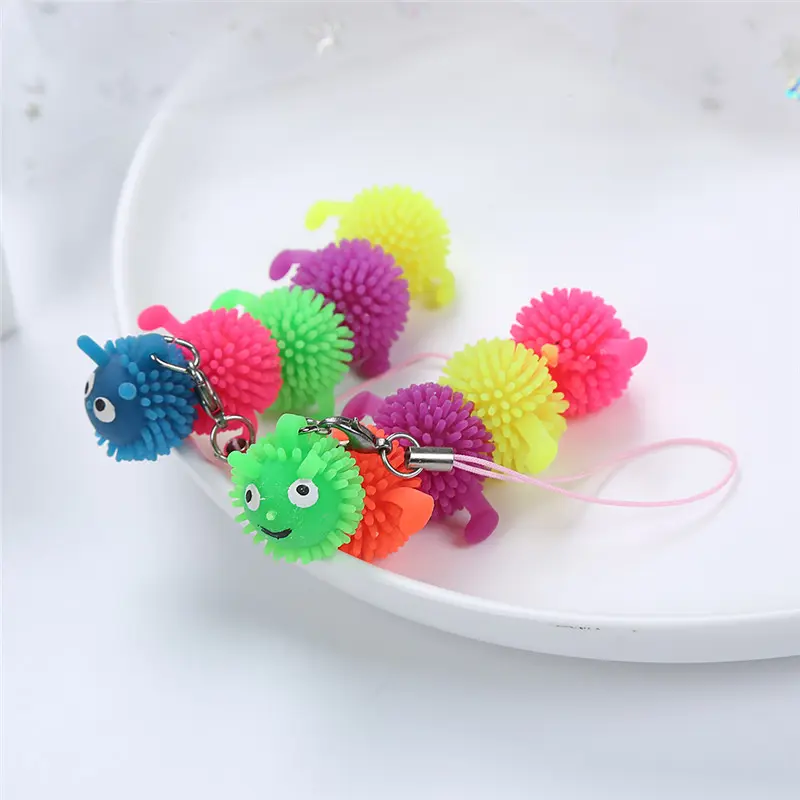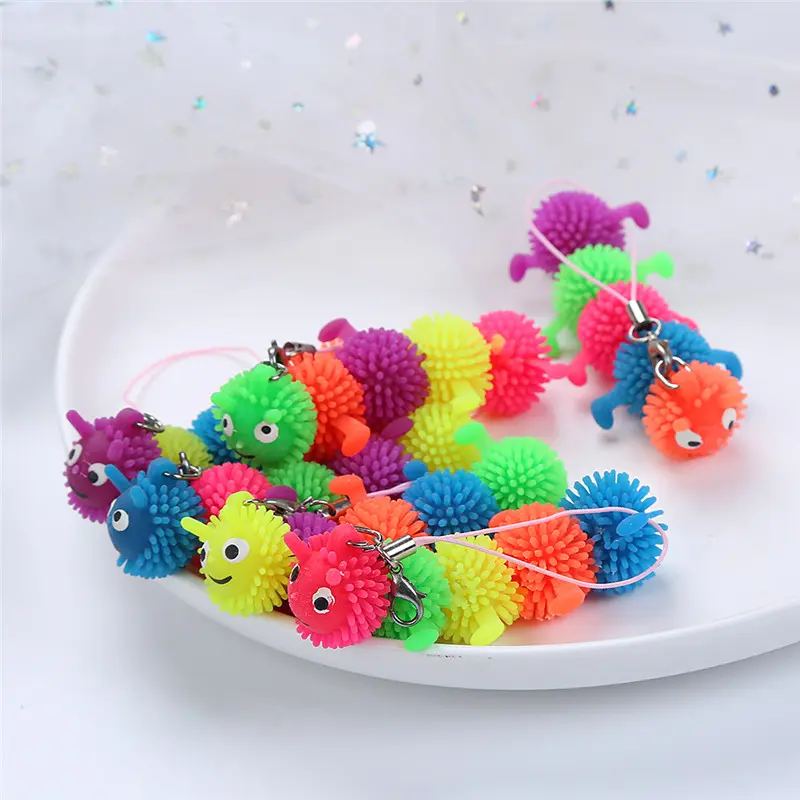Material characteristics of squeeze toys: a comprehensive analysis from tradition to innovation
In today’s toy market, squeeze toys have attracted the attention of many consumers with their unique decompression characteristics and fun. From soft sponges to high-tech environmentally friendly materials, the material selection of squeeze toys not only affects the appearance and touch of the toys, but also their safety and durability. This article will explore the material characteristics of squeeze toys in depth and show you how these materials shape the unique charm of squeeze toys.
1. Traditional plastic materials: a classic choice
Plastic is one of the most common materials in squeeze toys and is widely used due to its good processing performance, low cost and wide applicability. Common plastic materials include polyethylene (PE), polypropylene (PP) and polyvinyl chloride (PVC).
Polyethylene (PE)
Polyethylene is a lightweight, soft and elastic plastic material. It is often used to make soft squeeze toys, such as the outer layer of stuffed toys. PE material is non-toxic, odorless, and has good chemical corrosion resistance and impact resistance, making it an ideal choice for children’s toys. In addition, PE material is easy to process and mold, and can be made into toys of various shapes through various processes such as injection molding and blow molding.
Polypropylene (PP)
Polypropylene is known for its high strength and heat resistance. In squeeze toys, PP is often used for parts that require a certain hardness and toughness, such as the shell or supporting structure of the toy. PP material has good bending and fatigue resistance, and can maintain its shape during repeated squeezing and stretching. In addition, the lightweight characteristics of PP material give it an advantage in toy design, which can reduce the overall weight of the toy.
Polyvinyl chloride (PVC)
PVC is a versatile plastic material that is widely used in various toys. PVC material has good elasticity and wear resistance, and can withstand large pressure without deformation. In addition, PVC material is easy to color and print, and can produce colorful and richly patterned squeeze toys. However, PVC material may contain harmful substances such as plasticizers during the production process, so its safety needs to be strictly controlled in children’s toys.
2. Rubber material: the perfect combination of softness and elasticity
Rubber material has become an indispensable material in squeeze toys because of its soft texture and good elasticity. Rubber materials mainly include natural rubber and synthetic rubber.
Natural rubber
Natural rubber comes from the latex of rubber trees and has excellent elasticity and wear resistance. Natural rubber materials are moderately soft, have good resilience, and are non-irritating to the skin, making them ideal for making soft squeeze toys. However, the supply of natural rubber is greatly affected by climate change and fluctuations in production, and prices may fluctuate as a result.
Synthetic rubber
Synthetic rubber is produced by chemical methods and has good weather resistance and aging resistance. Compared with natural rubber, synthetic rubber is more stable in performance and can maintain elasticity over a wider temperature range. In addition, synthetic rubber can adjust its hardness and elasticity by adding different ingredients to meet the needs of different toy designs.
3. Metal materials: a guarantee of firmness and durability
Although metal materials are not the main materials in squeeze toys, metal parts play a key role in some special designs. For example, metal springs can provide additional elasticity and support, while metal decorative parts can increase the beauty of the toy.
Metal springs
Metal springs are usually made of high-strength steel wire and have excellent elasticity and durability. In squeeze toys, metal springs can provide stable support and resilience, allowing the toy to return to its original shape after repeated squeezing. However, the use of metal springs requires special attention to its safety to avoid sharp edges causing harm to children.
Metal decorative parts
Metal decorative parts such as rivets and screws are often used to connect and fix toys. These decorative parts not only enhance the structural stability of toys, but also enhance the appearance design of toys. The selection of metal decorative parts needs to consider the safety and non-toxicity of their materials to ensure that they meet the safety standards of children’s toys.
4. New environmentally friendly materials: a green and safe future
With the improvement of environmental awareness, new environmentally friendly materials have gradually become the mainstream choice for extruded toys. These materials not only meet environmental protection requirements, but also improve performance, providing more possibilities for toy design.
Bioplastics
Bioplastics are a type of plastic material made from renewable resources (such as corn starch). Compared with traditional plastics, bioplastics have good biodegradability and can be decomposed in the natural environment, reducing pollution to the environment. The processing performance of bioplastics is similar to that of traditional plastics. They can be made into toys of various shapes and have good elasticity and durability.
Recyclable rubber
Recyclable rubber is a material that is recycled and processed from waste rubber products. This material has good elasticity and wear resistance, and the impact on the environment is reduced during the production process. The use of recyclable rubber not only meets environmental protection requirements, but also reduces production costs, providing support for the sustainable development of squeeze toys.
Low-rebound materials (memory sponges)
Low-rebound materials, such as polyurethane slow-rebound sponges, are materials with viscoelastic properties. This material is soft and has a strong impact energy absorption capacity, providing a comfortable touch and a slow rebound effect. Low-rebound materials are often used to make squeeze toys that simulate food or soft objects, and their unique touch and visual effects make them popular in the market.
V. Material selection and application: considerations from design to production
The material selection of squeeze toys depends not only on their physical and chemical properties, but also on factors such as design requirements, target user groups, and cost budgets.
Design requirements
The design requirements of toys determine the choice of materials. For example, soft squeeze toys require the use of highly elastic materials such as natural rubber or low-rebound sponges; while parts that require a certain hardness and toughness can choose polypropylene or ABS plastics. In addition, the color, pattern, and texture of the toy will also affect the choice of materials. For example, PVC materials are widely used in colorful toys due to their good printing properties.
Target user group
The age and usage scenarios of the target user group are also important factors in selecting materials. For infant toys, the safety and non-toxicity of the materials are the primary considerations, such as bioplastics and natural rubber are ideal choices. For adolescent and adult toys, the durability and innovation of the materials are more important, such as high-strength plastics and low-rebound materials.
Cost budget
The cost of materials directly affects the market price of toys. Although environmentally friendly materials such as bioplastics and recyclable rubber have advantages in environmental performance, their production costs may be high. Therefore, when selecting materials, it is necessary to find a balance between environmental performance, safety and cost to ensure the market competitiveness of the product.
VI. Innovation and development trends of materials: unlimited possibilities in the future
With the advancement of technology and changes in consumer demand, the materials of squeeze toys are constantly innovating, showing the following development trends.
Application of smart materials
Smart materials such as temperature-changing materials and light-changing materials are gradually used in squeeze toys. These materials can change color or form according to changes in temperature or light, adding fun and interactivity to toys. For example, temperature-changing materials can change color when held in children’s hands, providing visual surprises.
Multi-material composite use
In order to meet the diverse design needs of toys, the use of multi-material composites has become a trend. For example, the combination of plastic and rubber can provide better elasticity and durability; the combination of metal and plastic can enhance the structural stability and aesthetics of toys. The application of this composite material not only improves the performance of toys, but also provides designers with more creative space.
Environmental protection and sustainable development
The use of environmentally friendly materials will continue to promote the development of the squeeze toy industry. In the future, more materials made from renewable resources will be used in toy production, such as bioplastics and recyclable rubber. These materials not only reduce the impact on the environment, but also meet consumers’ demand for environmentally friendly products, injecting new vitality into the toy industry.
VII. Conclusion
The material selection of squeeze toys is a key factor affecting their quality, safety and market competitiveness. From traditional plastics and rubber to new environmentally friendly materials, each material has its unique characteristics and application scenarios. With the improvement of environmental awareness and the advancement of science and technology, the materials of squeeze toys in the future will be more diversified and innovative, bringing consumers more safe and interesting product choices.
Whether it is soft natural rubber or high-tech low-rebound sponge, these materials are shaping the unique charm of squeeze toys. Choosing the right material can not only meet design requirements, but also improve user experience and promote the sustainable development of the entire industry. I hope this article will help you understand the material characteristics of squeeze toys, and I also look forward to the emergence of more innovative materials in the future, which will bring unlimited possibilities to squeeze toys.
Post time: Apr-09-2025

